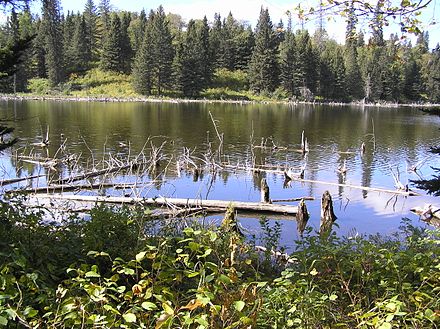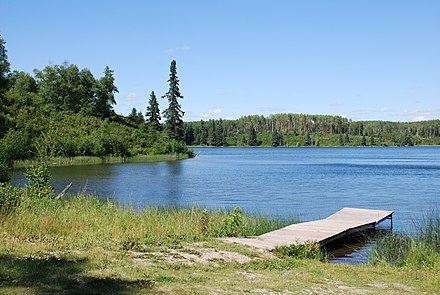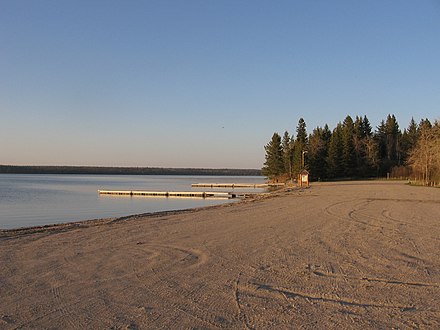Riding Mountain National Park - national park in Manitoba, Canada
Riding Mountain National Park is in the Prairie Mountain region of Manitoba. The park was established in 1929 to protect an area of 2,969 km² of prairie parkland, and designated as part of a UNESCO Biosphere Reserve in 1986.
Understand
- The only community in the national park is Wasagaming (often referred to as Clear Lake).
- The Visitor Centre is open mid-May to June and Sept to early Oct: 9:30AM-5:30PM, and July and Aug: 9:30AM-8PM.
 Contact the park office +1 204-848-7275 or email: rmnp.info@pc.gc.ca
Contact the park office +1 204-848-7275 or email: rmnp.info@pc.gc.ca
The park sits atop the Manitoba Escarpment. Consisting of a protected area 2,969 km² (1,146 sq mi), the forested parkland stands in sharp contrast to the surrounding prairie farmland. It was designated a national park because it protects three different ecosystems that converge in the area; grasslands, upland boreal and eastern deciduous forests.
History
The first trading post was established on Lake Dauphin north of the present-day park by Hudson's Bay Company in 1741. Pierre de la Verendrye and sons explored the region and traded with First Nations, who hunted and fished in the area for many years. In 1858 Henry Youle Hind, a professor of Biology and Chemistry at the University of Toronto, became one of the first Canadian explorers to reach the area now encompassed by the park during his surveying of what is now Manitoba and Saskatchewan. His explorations helped inform the Government of Canada of the ecological diversity and potential of the Riding Mountain region.
Much of the public infrastructure in Riding Mountain National Park was created during the 1930s by labourers participating in Canada's great depression relief programs. Ten relief camps we're established as a result of the 1930 Unemployment Relief Act and the 1934 Public Works Construction Act. In 1932 most relief workers were British and over half were from Winnipeg. At this time the 1½-storey interpretive centre and several other buildings were built of log, many featuring a rustic architectural style. A lot of this early construction survives to this day.
In the early days of Riding Mountain National Park, Parks Branch Commissioner James Harkin offered Archibald Belaney a job in the region. Belaney, who adopted the name Grey Owl when he took up a First Nations identity as an adult, was a writer and became one of Canada's first conservationists. On April 17, 1931, Grey Owl arrived with his two beavers at a secluded lake several kilometres north of Wasagaming which had been selected by the park staff. He spent six months living in a cabin in Riding Mountain National park studying and working with wildlife, including two beavers named Jelly Roll and Rawhide. His main goal in the park was to re-establish beaver colonies in areas where they had been exterminated. Riding Mountain National Park was found to be an unsuitable habitat for the beavers, as a summer drought resulted in the lake water level sinking, and becoming stagnant. Both the beavers and Belaney were unhappy with the situation, causing Belaney to search for better living conditions. He relocated to Prince Albert National Park, where there was a larger waterway and less risk of the lakes freezing to the bottom in the winter. He is regarded as a legend and major historical figure because of the influence he had on Riding Mountain National Park. The park now has an abundant beaver population partially because of his efforts. His living quarters, now known as "Grey Owl's Cabin", still stand and are a popular tourist attraction.
During World War II, the park was home to the Whitewater labour camp for German prisoners of war. Operating from 1943 to 1945, the camp was built on the northeast shore of Whitewater Lake, approximately 300 km (190 mi) north-west of Winnipeg. The camp consisted of 15 buildings and housed 440 to 450 prisoners of war. The decision to have a prisoner-of-war labour project in the park was the result of a fuelwood shortage in the winter of 1942 and 1943. To free up men for the war effort it was decided that prisoners of war would be employed. Following the end of the war and the achievement of a fuelwood surplus, the camp closed in late 1945. The camp has since been dismantled.
In 1986 the United Nations Educational, Scientific and Cultural Organization (UNESCO) designated Riding Mountain National Park and the surrounding area Riding Mountain Biosphere Reserve, as part of its Man and the Biosphere Programme. The Biosphere Reserve is a non-profit volunteer organization managed by representatives from the surrounding area. A Biosphere Reserve Management Committee (BRMC) was created to oversee the area. Biosphere Reserve land outside of Riding Mountain National Park is both privately and publicly owned and managed.
Landscape

Flora and fauna
Riding Mountain is a vibrant wilderness oasis, set high above a sea of prairie agricultural lands. Located in the centre of North America, the Boreal Forest, Aspen Woodland, Prairie and Eastern Hardwood Biomes come together. These Biomes, occur on a hilly, 'Pot-and Kettle' glacial moraine with fertile soils and an abundance of wetlands, streams and lakes. This biogeophysical phenomenon creates a mosaic of flourishing ecosystems with an incredible diversity of plant and animal species.
Elk, porcupines, coyotes, moose, wolves, beavers, lynxes, white-tailed deer, snowshoe hares, and cougars are among the animals that roam around this park. Common loons and Canada geese are some of Clear Lake's bird inhabitants. 233 bird species observed in the park. The park also boasts one of the largest populations of black bears in North America. The black bear is one of 60 species of mammals inhabiting the park. There is also a wild bison enclosure located near Lake Audy. 20 bison were reintroduced from Alberta in 1931. As of 2016, Lake Audy supports a population of about 40 captive bison.
Riding Mountain National Park is also well known for its wildflowers and wide range of unique vegetation, most of which is not seen anywhere else in the prairie regions of Canada. There are 669 species of plants in the park. Vegetation common to the region includes aspen poplar, balsam poplar, white birch or paper birch, white spruce, balsam fir, jack pine, black spruce, tamarack, American elm, Manitoba maple, and bur oak.
Climate
The climate in the Riding Mountain region is similar to that of other regions of southwestern Manitoba: a continental climate. It includes grasslands, upland boreal and eastern deciduous forest ecosystems.
The park has hot summers and cold winters, with annual rainfall ranging from 40.6 to 50.8 cm. Around 80 percent of rainfall occurs between the months of April and October, with June being the wettest month of the year. The increased precipitation during the summer months is due to the large number of lakes and wetlands within the region as well as turbulence caused by the surrounding Manitoba escarpment.
During the winter at an elevation of about 732 m the mean snowfall is 127 cm. At a lower altitude of about 335 m the snowfall drops to 25.4 cm. The town site Wasagaming has an average July temperature of 16.5 °C and an average January temperature of -19.7 °C. In general there are fewer humid days within the park than in the surrounding prairie region. Wasagaming has lighter winds than the rest of the park due to the surrounding forest cover.
Get in
Provincial Highway 10 bisects the eastern half of the national park. Brandon is approximately 100 km to the south, Dauphin approximately 30 km to the north. During the winter months, it is not uncommon for Highway 10 to be closed during poor weather. Check local road conditions via Manitoba Infrastructure and Transportation or listen to a local radio station.
The park is 3½ hours west of Winnipeg and 3 hours east of Yorkton. The nearest commercial airports are at Dauphin and Brandon. A motor vehicle permit is required and can be purchased at the park gateways.
The closest bus service from Winnipeg will only get you to Dauphin (Nov 2019). From there, you can take a 35-min taxi trip to the park.
Fees and permits
The 2018 daily/annual entrance fees for Riding Mountain National Park are:
- Adult $7.80/$ 39.20
- Senior $6.55/$ 34.30
- Children and youth under 18 free
- Family/group $15.70/$ 78.50
Fishing permits (2018):
- Daily $ 9.80
- Annual $ 34.30
Get around
See
Do
Riding Mountain National Park has over 400 km (250 mi) of trails, with surfaces ranging from being grassy to gravelled. Backpacking trails include Ochre River Trail, South Escarpment Trail, and the Tilson Lake Trail. The Central, Baldy Lake and Strathclair trails are easy cycling trails while the Packhorse, Jet and Baldy Hill trails are more difficult. On most back-country trails horse use is allowed, equipment being provided by local outfitters. During the winter months trails are open to cross-country skiing, which are not patrolled daily.
- Loon's Island Trail, 50.6606°, -99.8951°. This trail is a 2.2-km round-trip trail that gains of elevation over its length. From the parking lot follow the trail to the left of the sign. The trail winds through the forest with short, gentle climbs and descents. At 1.0 you reach a trail junction. Turn to the right. The trail to the left is the Lake Katherine ski trail. At 1.1 you reach a nice view of the lake. In theory, this is a loop trail, but it is sometimes flooded. If the water level is lower, you may be able to follow the return portion of the trail to return to the parking lot. Otherwise, turn around and retrace your steps to where you started.
- Ochre River Trail. Deep within Riding Mountain National Park, beginning just off Highway #10 and then winding its way through thick forest down to a parking lot on the north-eastern boundary of the park. Highlights along this trail include scenic campsites, river views, stream crossings, and a serene forest setting. The trail is used by backpackers, bikers, horseback riders, and cross country skiers. Skiers can make an over-night trek from the South Trailhead to Cairn’s Cabin (about 800 m off the trail near the Ochre River Campsite) for the night and then back out again the following day. This cabin must be booked and paid for in advance. This trail has not been maintained since 2011.
- Tilson Lake Loop. A multipurpose trail in the western portion of the park, which is not as heavily forested as the eastern side, and provides views over open meadows and rolling hills for hikers, horseback riders and bikers. The trail is 2-day loop and takes hikers an average of 11 hours to hike, but which can be joined up with some of the nearby trails to create a longer trip. The trail has few markings, but is wide and difficult to lose, and there are large, green signs clearly marking all junctions along the way. There are two campsites on the trail which have privies, fire pits, food storage bins, firewood, picnic tables and plenty of space for tents. It is possible to snowshoe this trail in the winter, but access can be difficult after heavy snow fall. This trail has not been maintained since 2011.
- Fishing. National Park Fishing Licenses are required for fishing within park boundaries. There are many clean, freshwater lakes within the park including Clear Lake, Lake Audy, Moon Lake and Whirlpool Lake among others. Walleye, white fish and perch are found in Clear Lake, and a limited number of rainbow and brook trout can be found in Lake Katherine and Deep Lake. Ice fishing is allowed on Clear Lake during the winter months. Snowmobiling is allowed on Clear Lake for ice fishing only.
- Boating. Clear Lake and Lake Audy have boat launches, both of which can be used for motorized boats. Moon Lake can also be used for this purpose though equipment must be carried 300 m. On Whirlpool Lake, Deep Lake, Lake Katherine, and back-country lakes, only non-motorized boats can be used. All personal water crafts are banned within Riding Mountain National Park. Only four-stroke and direct injected two-stroke equipped motor boats are permitted on Clear Lake. Boats equipped with other motors are not permitted to use the lake for environmental reasons. The ban is enforced by Parks Canada and the RCMP.
- Canoeing and kayaking. The lakes of Riding Mountain provide excellent conditions for canoeing and kayaking. At times, Whirlpool River and Jackfish Creek can be used for canoeing and kayaking when the water is high enough, usually after heavy rains or spring runoff.
- Sailing. Clear Lake is used by many people for sailing because of its relatively large size, and wind patterns. Parking and assembly areas are located at the Wasagaming boat launch. 2018-03-31
- Swimming and Scuba Diving. The Clear Lake main beach at Wasagaming, one of the park's most popular swimming locations, is equipped with washrooms, change rooms, and outdoor showers. Scuba diving is also possible at Clear Lake, with the deepest point in the lake approximately 34.7 m (114 feet). Other lakes used for swimming are Lake Katherine, Lake Audy and Moon Lake. Most of the other lakes in the park have muddy bottoms, so swimming is difficult but possible. 2018-03-31
- Golfing. Clear Lake Golf Course is located within park boundaries along the shores of Clear Lake. The course has received high ratings from several North American golf publications. 2018-03-31
- Tennis. There are six professional tennis courts in the park at the Wasagaming townsite. 2018-03-31
Buy
Eat
Drink
Sleep
Lodging
Per night, shoulder/peak season (2018):
- Yurt - $ 90.00/$ 100.00
- oTENTik (tent on platforms with beds for up to six people) $ 90.00/$ 100.00
- Riding Mountain House, 56 Meadowview Drive Onanole (On the edge, just south of the national park), 50.6443°, -99.9868°, +1 204-848-3333, ridingmountainhouse@gmail.com. Check-in: 4PM, check-out: 11AM. $149/night 2022-07-13
Camping
- Wasagaming Campground. Wasagaming campground is one of the largest in Manitoba, and is a full service campground located near the Wasagaming townsite and Clear Lake. All sites in the Wasagaming campground contain a fire box, picnic table, and access to washrooms at the unserviced camp sites, and full service sites are equipped with all modern amenities including sewer, electricity, water, picnic table, and fire box. $27.40-38.50
Unserviced frontcountry campgrounds area also available:
- Moon Lake Campground, Moon Lake. $15.70
- Lake Audy Campground, Lake Audy. $15.70
- Whirlpool Campground. $15.70
- Deep Lake Campground, Deep Lake. $15.70
Backcountry
Backcountry campsites are also available; reservations can be made online.
Stay safe
Riding Mountain National Park is a safe area to visit, however, common sense is required. Key safety concerns in the park include:
- Poison ivy
- Black bears: Riding Mountain is home to a population of black bears.
- Swimmer's Itch
Be careful when doing outdoor activities during the winter time as temperature can reach as low as -40°C so check local television/radio when going out.
Go next
Riding Mountain National Park
pc.gc.ca/fra/pn-np/mb/riding/index.aspxDate Time:Please wait...Timezone:America/WinnipegCoordinates:50.86, -100.04
Manitoba
Primary administrative division

